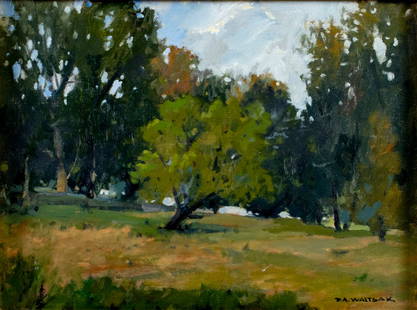




Item Details
Description
ROBERT CARVER (C. 1730-91) A Capriccio Landscape based on Dunmoe Castle, County Meath Oil on canvas, 62 x 102cm Dunmoe Castle, County Meath, started by Hugh de Lacy, captured by the Irish in 1641, attacked by Cromwell and restored under James II, was a site much visited by artists and antiquarians in the eighteenth century. Its proximity to Slane Castle, home of William Burton Conyngham (1733-1796), the collector and improver, no doubt encouraged its depiction and when a view of the castle by Thomas Roberts (1748-1777) was engraved for Francis Grose’s Antiquities it was described as ‘taken from an original in the collection of the Right Hon. William Conyngham’. As Peter Harbison has so ably demonstrated, Burton Conyngham was a collector and patron of rare judgment for eighteenth century Ireland who, almost single-handed, encouraged artists to consider the native ruins of Ireland as a subject for their landscapes which were compositionally often inspired by Claudean prototypes. His support of of young artists is most apparent in his collecting of drawings for various antiquarian enterprises. He provided financial and other support to a group of draughtsmen most notably Austin Cooper and Gabriel Beranger, as well as Angelo Maria Bigari and John James Barralet. In 1779, for example, Beranger and Bigari conducted a tour of Connacht at Burton’s behest, which has been characterised as ‘the most extensive archaeological survey undertaken in Ireland before the Ordnance Survey’. Burton’s patronage resulted in his ownership of what was described in 1787 as ‘the finest collection [of antiquarian drawings] made by excellent artists anywhere to be found’. Two views of Slane Abbey, copied by Beranger after originals by Jonathan Fisher (1735-1809) may have been a Conyngham commission, with Harbison suggesting that Fisher probably drew them while staying at Slane Castle. Roberts drawing of Dunmoe was engraved by Sparrow and also copied by Gabriel Bernager who inscribed his version with the proviso: ‘Compared on the spot 1779 and I found it exact except the colour which is blueish and not brown’. While Robert Carver was not one of Conyngham’s ‘young artists’, he was closely connected with several of The Dublin Group who were, notably Roberts – they both seem to have taught James Coy (c.1750-80) and were both intimate associates of George Mullins (fl. c.1756-c.1786). Roberts later re-used his sketch of Dunmoe Castle in an imaginary landscape (private collection) in just the same way that Carver does here, ‘illustrating how the antiquarianism of Burton’s circle was creatively adapted by the artists he patronised and how the reuse of elements of Ireland’s antiquities give…a distinctively Irish flavor to Roberts art.’ Exactly the same can be said in relation to Carver’s capriccio landscape sold here, where Dunmoe’s setting above the River Boyne is augmented with a typically Irish tower house on one bank of the river and a substantial red-brick structure and small church, on either side of a bridge, on the other. Carver, like other artists, responded to the setting with the castle ‘magnificently sited high above a bend in the Boyne’ (Casey and Rowan, The Buildings of Ireland, North Leinster, 225). Together with George Barret, Robert Carver was the leading landscape artist in Dublin in the 1750s and ’60s. He followed Barret to London in 1769 where he found fame, for his much-admired designs for the theatre, and status, as the President of Society of Artists. Although of an older generation, he was also closely connected with the talented coterie of artists who came to prominence in the 1760s and ‘70s and who, with Carver, can be seen as a closely interlocked ‘Dublin Group’ of landscape painters. No doubt his ‘generous and companionable qualities’ made him a mentor to younger painters. Carver’s easel paintings are rare and mostly date from his period in Ireland – the present work seems to be unique in including Irish architectural, or antiquarian remains. However, as more of them are identified his ability becomes apparent and the reasons become obvious for the contemporary praise which was showered on his productions. Here, the red dress of the reclining woman in the foreground provides an effective chromatic highlight at the centre of the composition, while the busy few inches of the paint surface including the figures and animals contrasts with the unbroken sheen of the river with long reflections cast by the late afternoon sun adding a slightly elegiac touch to the romantic, umbrageous Boyne landscape. Picturesque travellers in the foreground add a bucolic touch. The picture is painted in Carver’s early and tighter style, before his touch became free, and occasionally loose, from his experience of scene painting. An almost exact parallel can be found in the precise, almost schematic, rendering of light effects on the different facades on the brick building and on a mill in a River Landscape with Figures (Gorry Gallery, Exhibition, 19 May 2010). We are grateful to William Laffan for his assistance in cataloguing this lot.
Buyer's Premium
- 30%
ROBERT CARVER (C. 1730-91) A Capriccio Landscape based on Dunmoe Castle, County Meath Oil on canvas,
Estimate €30,000 - €50,000
Starting Price
€15,000
3 bidders are watching this item.
Get approved to bid.
Shipping & Pickup Options
Item located in Ireland, Dublin, IESee Policy for Shipping
Local Pickup Available
Payment

The Library Collection
Ireland, Dublin, IE
Related Paintings
More Items in Paintings
View MoreRecommended Art
View MoreTOP











































































